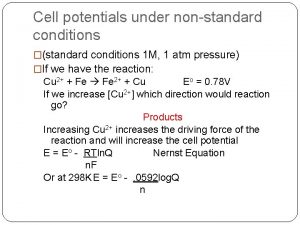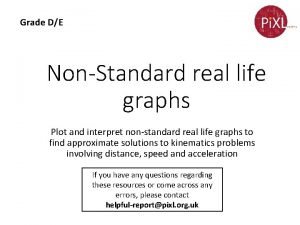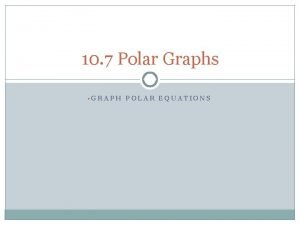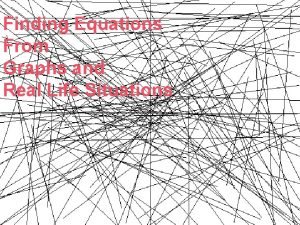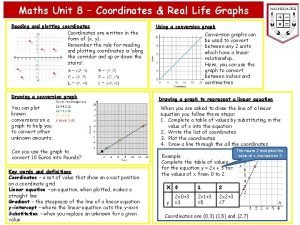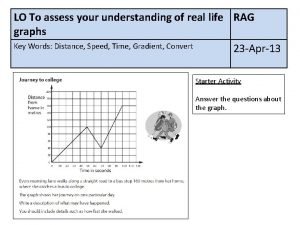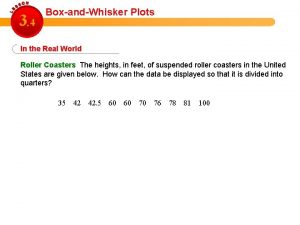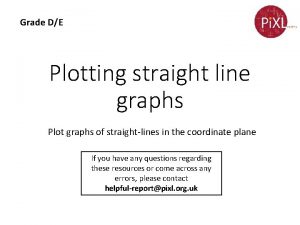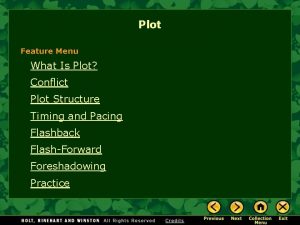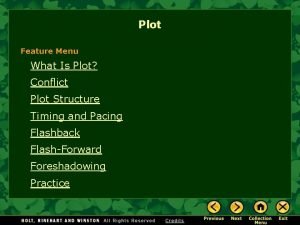Grade DE NonStandard real life graphs Plot and











- Slides: 11

Grade D/E Non-Standard real life graphs Plot and interpret non-standard real life graphs to find approximate solutions to kinematics problems involving distance, speed and acceleration If you have any questions regarding these resources or come across any errors, please contact helpful-report@pixl. org. uk

Key Vocabulary Graph Distance Time Speed Acceleration Deceleration Constant At rest

How to plot a non-standard real life graph 1) Plot the following journey as a distance-time graph: • A car makes a journey to a town 12 km away and then returns. • The car initially travels at 0. 6 km/h (AB) before coming to rest after 5 hrs. speed x time = distance 0. 6 x 5 = 3 km • After 3 hrs pass (BC), the car travels for a further 4 hrs until it reaches the town (CD). 12 km – 3 km = 8 km • After spending 2 hrs in the town (DE), the car returns home in 6 hrs (EF). The car travels 12 km in 6 hrs but in the opposite direction!

How to plot a non-standard real life graph 1) Now plot this information on the graph AB) 3 km in 5 hrs BC) 0 km in 3 hrs CD) 8 km in 4 hrs DE) 0 km in 2 hrs EF) 12 km in 6 hrs

How to use non-standard real life graphs to solve problems 1) a) Describe the motion of the bike between each points. b) What was the maximum speed of the bike? Constant speed Constant acceleration Constant deceleration c) What does the gradient represent? d) Calculate the maximum acceleration of the bike. e) Calculate the total distance travelled by the bike. Constant speed Constant acceleration stationary The speed The bike’s speed. The speed remains is constantly remains The bike’s speed The Bike’s the same increasing with the same speed is The speed is constantly time constantly is 0 m/s increasing with decreasing time with time

How to use non-standard real life graphs to solve problems 1) a) Describe the motion of the bike between each points. b) What was the maximum speed of the bike? Constant speed Constant acceleration Constant deceleration 10 m/s c) What does theb)gradient represent? c) Change of speed with time i. e. acceleration d) Calculate the maximum acceleration of the bike. e) Calculate the total distance travelled by the bike. d) The steepest positive gradient occurs between A and O. Acceleration = gradient = 10/5 = 2 m/s² Constant speed Constant acceleration stationary Total distance travelled = area under the graph This is because distance = speed x time e) Total distance = 10(5+13)/2 + 5(4+9)/2 =122. 5 m²

How to plot and interpret nonstandard real life graph- now you try A car driving on a road accelerated for 125 m in 5 seconds. After reaching its maximum speed, it travelled at a constant velocity for 2 seconds before decelerating to a stop, making the total journey time 8 seconds. a) Draw the speed-time graph for the car’s motion, labelling the motion of the car at each stage b) Calculate the car’s acceleration c) Calculate the car’s total distance travelled

How to plot and interpret nonstandard real life graph- now you try 60 Constant speed Speed (m/s) 50 b) Acceleration = gradient = 50/5 = 10 m/s² 40 acceleration 30 deceleration 20 10 0 0 1 2 3 4 5 Time (s) 6 7 8 c) Distance travelled = total area = 125 + (2 x 50) + (½ x 1 x 50) = 250 m

Problem Solving and Reasoning This graph shows distance against time of two objects. a) Describe both graphs at each stage b) What was the maximum speed of the blue object? c) Assume that the red object continued at the same speed for a further 20 seconds. What would its total distance travelled be?

Problem Solving and Reasoning This graph shows distance against time of two objects. a) Describe both graphs at each stage b) What was the maximum speed of the blue object? stationary (2) Constant speed (1) 10 km/6 hrs = 1. 67 km/hr (2) 4 km/3 hrs = 1. 33 km/hr So max speed = 1. 67 km/hr c) Assume that the red object continued at the same speed for a further 20 seconds. What would its total distance travelled be? Red speed = 14 km/16 hrs = 0. 875 km/hr As distance = speed x time Total distance = 0. 875 x (16+20) = 31. 5 km

Reason and explain • How would you show a decreasing acceleration on a speed-time graph? • How would you represent constant speed on an acceleration-time graph? • What does zero acceleration suggest about the speed?
 Standard english
Standard english How to find cell potential under nonstandard conditions
How to find cell potential under nonstandard conditions Real life graphs
Real life graphs Polar graphs in real life
Polar graphs in real life Statistics misleading graphs
Statistics misleading graphs Graphs in real life situations
Graphs in real life situations Polar coordinates in real life
Polar coordinates in real life Real life graphs
Real life graphs Real life graphs
Real life graphs Transition bugs in software testing
Transition bugs in software testing Graphs that enlighten and graphs that deceive
Graphs that enlighten and graphs that deceive Box plots in real life
Box plots in real life

